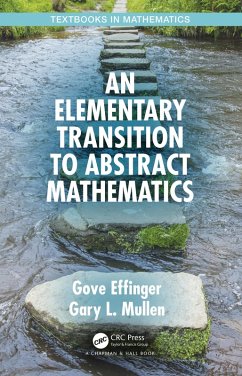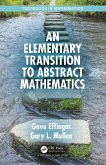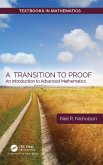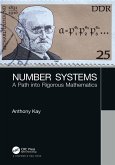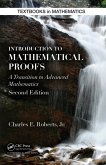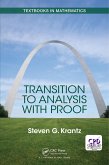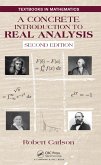45,95 €
45,95 €
inkl. MwSt.
Sofort per Download lieferbar

23 °P sammeln
45,95 €
Als Download kaufen

45,95 €
inkl. MwSt.
Sofort per Download lieferbar

23 °P sammeln
Jetzt verschenken
Alle Infos zum eBook verschenken
45,95 €
inkl. MwSt.
Sofort per Download lieferbar
Alle Infos zum eBook verschenken

23 °P sammeln
- Format: PDF
- Merkliste
- Auf die Merkliste
- Bewerten Bewerten
- Teilen
- Produkt teilen
- Produkterinnerung
- Produkterinnerung

Bitte loggen Sie sich zunächst in Ihr Kundenkonto ein oder registrieren Sie sich bei
bücher.de, um das eBook-Abo tolino select nutzen zu können.
Hier können Sie sich einloggen
Hier können Sie sich einloggen
Sie sind bereits eingeloggt. Klicken Sie auf 2. tolino select Abo, um fortzufahren.

Bitte loggen Sie sich zunächst in Ihr Kundenkonto ein oder registrieren Sie sich bei bücher.de, um das eBook-Abo tolino select nutzen zu können.
This text is intended to help students move from introductory courses to those where rigor and proof play a much greater role. The emphasis is on precise definitions of mathematical objects and rigorous proofs of properties.
- Geräte: PC
- ohne Kopierschutz
- eBook Hilfe
- Größe: 3.46MB
Andere Kunden interessierten sich auch für
![An Elementary Transition to Abstract Mathematics (eBook, ePUB) An Elementary Transition to Abstract Mathematics (eBook, ePUB)]() Gove EffingerAn Elementary Transition to Abstract Mathematics (eBook, ePUB)45,95 €
Gove EffingerAn Elementary Transition to Abstract Mathematics (eBook, ePUB)45,95 €![Exploring the Infinite (eBook, PDF) Exploring the Infinite (eBook, PDF)]() Jennifer BrooksExploring the Infinite (eBook, PDF)45,95 €
Jennifer BrooksExploring the Infinite (eBook, PDF)45,95 €![A Transition to Proof (eBook, PDF) A Transition to Proof (eBook, PDF)]() Neil R. NicholsonA Transition to Proof (eBook, PDF)45,95 €
Neil R. NicholsonA Transition to Proof (eBook, PDF)45,95 €![Number Systems (eBook, PDF) Number Systems (eBook, PDF)]() Anthony KayNumber Systems (eBook, PDF)60,95 €
Anthony KayNumber Systems (eBook, PDF)60,95 €![Introduction to Mathematical Proofs (eBook, PDF) Introduction to Mathematical Proofs (eBook, PDF)]() Charles RobertsIntroduction to Mathematical Proofs (eBook, PDF)100,95 €
Charles RobertsIntroduction to Mathematical Proofs (eBook, PDF)100,95 €![Transition to Analysis with Proof (eBook, PDF) Transition to Analysis with Proof (eBook, PDF)]() Steven KrantzTransition to Analysis with Proof (eBook, PDF)80,95 €
Steven KrantzTransition to Analysis with Proof (eBook, PDF)80,95 €![A Concrete Introduction to Real Analysis (eBook, PDF) A Concrete Introduction to Real Analysis (eBook, PDF)]() Robert CarlsonA Concrete Introduction to Real Analysis (eBook, PDF)45,95 €
Robert CarlsonA Concrete Introduction to Real Analysis (eBook, PDF)45,95 €-
-
-
This text is intended to help students move from introductory courses to those where rigor and proof play a much greater role. The emphasis is on precise definitions of mathematical objects and rigorous proofs of properties.
Dieser Download kann aus rechtlichen Gründen nur mit Rechnungsadresse in A, B, BG, CY, CZ, D, DK, EW, E, FIN, F, GR, HR, H, IRL, I, LT, L, LR, M, NL, PL, P, R, S, SLO, SK ausgeliefert werden.
Produktdetails
- Produktdetails
- Verlag: Taylor & Francis eBooks
- Seitenzahl: 292
- Erscheinungstermin: 5. November 2019
- Englisch
- ISBN-13: 9781000701814
- Artikelnr.: 58077724
- Verlag: Taylor & Francis eBooks
- Seitenzahl: 292
- Erscheinungstermin: 5. November 2019
- Englisch
- ISBN-13: 9781000701814
- Artikelnr.: 58077724
- Herstellerkennzeichnung Die Herstellerinformationen sind derzeit nicht verfügbar.
Gove Effinger received his Ph.D. in Mathematics from the University of Massachusetts (Amherst) in 1981 and subsequently taught at Bates College for 5 years and then Skidmore College for 29 years. He is the author of two books: Additive Number Theory of Polynomials over a Finite Field (with David R. Hayes), and Common-Sense BASIC: Structured Programming with Microsoft QuickBASIC (with Alice M. Dean), as well as numerous research papers. His research focus has primarily been concerned with the similarities of the ring of polynomials over a finite field to the ring of ordinary integers.
Gary L. Mullen is Professor of Mathematics at the Pennsylvania State University, University Park, PA. He has taught both undergraduate and graduate courses there for over 40 years. In addition, he has written more than 150 research papers and five books, including both graduate as well as undergraduate textbooks. He also served as department head for seven years and has served as an editor on numerous editorial boards, including having served as Editor-in-Chief of the journal Finite Fields and Their Applications since its founding in 1995.
Gary L. Mullen is Professor of Mathematics at the Pennsylvania State University, University Park, PA. He has taught both undergraduate and graduate courses there for over 40 years. In addition, he has written more than 150 research papers and five books, including both graduate as well as undergraduate textbooks. He also served as department head for seven years and has served as an editor on numerous editorial boards, including having served as Editor-in-Chief of the journal Finite Fields and Their Applications since its founding in 1995.
A Look Back: Precalculus Math
A Look Back: Calculus
About Proofs and Proof Strategies
Mathematical Induction
The Well-Ordering Principle
Sets
Equivalence Relations
Functions
Cardinality of Sets
Permutations
Complex Numbers
Matrices and Sets with Algebraic Structure
Divisibility in Z and Number Theory
Primes and Unique Factorization
Congruences and the Finite Sets Zn
Solving Congruences
Fermat's Theorem
Diffie-Hellman Key Exchange
Euler's Formula and Euler's Theorem
RSA Cryptographic System
Groups-Definition and Examples
Groups-Basic Properties
Groups-Subgroups
Groups-Cosets
Groups-Lagrange's Theorem
Rings
Subrings and Ideals
Integral Domains
Fields
Vector Spaces
Vector Space Properties
Subspaces of Vector Spaces
Polynomials
Polynomials-Unique Factorization
Polynomials over the Rational, Real and Complex Numbers
Suggested Solutions to Selected Examples and Exercises
A Look Back: Calculus
About Proofs and Proof Strategies
Mathematical Induction
The Well-Ordering Principle
Sets
Equivalence Relations
Functions
Cardinality of Sets
Permutations
Complex Numbers
Matrices and Sets with Algebraic Structure
Divisibility in Z and Number Theory
Primes and Unique Factorization
Congruences and the Finite Sets Zn
Solving Congruences
Fermat's Theorem
Diffie-Hellman Key Exchange
Euler's Formula and Euler's Theorem
RSA Cryptographic System
Groups-Definition and Examples
Groups-Basic Properties
Groups-Subgroups
Groups-Cosets
Groups-Lagrange's Theorem
Rings
Subrings and Ideals
Integral Domains
Fields
Vector Spaces
Vector Space Properties
Subspaces of Vector Spaces
Polynomials
Polynomials-Unique Factorization
Polynomials over the Rational, Real and Complex Numbers
Suggested Solutions to Selected Examples and Exercises
A Look Back: Precalculus Math
A Look Back: Calculus
About Proofs and Proof Strategies
Mathematical Induction
The Well-Ordering Principle
Sets
Equivalence Relations
Functions
Cardinality of Sets
Permutations
Complex Numbers
Matrices and Sets with Algebraic Structure
Divisibility in Z and Number Theory
Primes and Unique Factorization
Congruences and the Finite Sets Zn
Solving Congruences
Fermat's Theorem
Diffie-Hellman Key Exchange
Euler's Formula and Euler's Theorem
RSA Cryptographic System
Groups-Definition and Examples
Groups-Basic Properties
Groups-Subgroups
Groups-Cosets
Groups-Lagrange's Theorem
Rings
Subrings and Ideals
Integral Domains
Fields
Vector Spaces
Vector Space Properties
Subspaces of Vector Spaces
Polynomials
Polynomials-Unique Factorization
Polynomials over the Rational, Real and Complex Numbers
Suggested Solutions to Selected Examples and Exercises
A Look Back: Calculus
About Proofs and Proof Strategies
Mathematical Induction
The Well-Ordering Principle
Sets
Equivalence Relations
Functions
Cardinality of Sets
Permutations
Complex Numbers
Matrices and Sets with Algebraic Structure
Divisibility in Z and Number Theory
Primes and Unique Factorization
Congruences and the Finite Sets Zn
Solving Congruences
Fermat's Theorem
Diffie-Hellman Key Exchange
Euler's Formula and Euler's Theorem
RSA Cryptographic System
Groups-Definition and Examples
Groups-Basic Properties
Groups-Subgroups
Groups-Cosets
Groups-Lagrange's Theorem
Rings
Subrings and Ideals
Integral Domains
Fields
Vector Spaces
Vector Space Properties
Subspaces of Vector Spaces
Polynomials
Polynomials-Unique Factorization
Polynomials over the Rational, Real and Complex Numbers
Suggested Solutions to Selected Examples and Exercises
A Look Back: Precalculus Math
A Look Back: Calculus
About Proofs and Proof Strategies
Mathematical Induction
The Well-Ordering Principle
Sets
Equivalence Relations
Functions
Cardinality of Sets
Permutations
Complex Numbers
Matrices and Sets with Algebraic Structure
Divisibility in Z and Number Theory
Primes and Unique Factorization
Congruences and the Finite Sets Zn
Solving Congruences
Fermat's Theorem
Diffie-Hellman Key Exchange
Euler's Formula and Euler's Theorem
RSA Cryptographic System
Groups-Definition and Examples
Groups-Basic Properties
Groups-Subgroups
Groups-Cosets
Groups-Lagrange's Theorem
Rings
Subrings and Ideals
Integral Domains
Fields
Vector Spaces
Vector Space Properties
Subspaces of Vector Spaces
Polynomials
Polynomials-Unique Factorization
Polynomials over the Rational, Real and Complex Numbers
Suggested Solutions to Selected Examples and Exercises
A Look Back: Calculus
About Proofs and Proof Strategies
Mathematical Induction
The Well-Ordering Principle
Sets
Equivalence Relations
Functions
Cardinality of Sets
Permutations
Complex Numbers
Matrices and Sets with Algebraic Structure
Divisibility in Z and Number Theory
Primes and Unique Factorization
Congruences and the Finite Sets Zn
Solving Congruences
Fermat's Theorem
Diffie-Hellman Key Exchange
Euler's Formula and Euler's Theorem
RSA Cryptographic System
Groups-Definition and Examples
Groups-Basic Properties
Groups-Subgroups
Groups-Cosets
Groups-Lagrange's Theorem
Rings
Subrings and Ideals
Integral Domains
Fields
Vector Spaces
Vector Space Properties
Subspaces of Vector Spaces
Polynomials
Polynomials-Unique Factorization
Polynomials over the Rational, Real and Complex Numbers
Suggested Solutions to Selected Examples and Exercises
A Look Back: Precalculus Math
A Look Back: Calculus
About Proofs and Proof Strategies
Mathematical Induction
The Well-Ordering Principle
Sets
Equivalence Relations
Functions
Cardinality of Sets
Permutations
Complex Numbers
Matrices and Sets with Algebraic Structure
Divisibility in Z and Number Theory
Primes and Unique Factorization
Congruences and the Finite Sets Zn
Solving Congruences
Fermat's Theorem
Diffie-Hellman Key Exchange
Euler's Formula and Euler's Theorem
RSA Cryptographic System
Groups-Definition and Examples
Groups-Basic Properties
Groups-Subgroups
Groups-Cosets
Groups-Lagrange's Theorem
Rings
Subrings and Ideals
Integral Domains
Fields
Vector Spaces
Vector Space Properties
Subspaces of Vector Spaces
Polynomials
Polynomials-Unique Factorization
Polynomials over the Rational, Real and Complex Numbers
Suggested Solutions to Selected Examples and Exercises
A Look Back: Calculus
About Proofs and Proof Strategies
Mathematical Induction
The Well-Ordering Principle
Sets
Equivalence Relations
Functions
Cardinality of Sets
Permutations
Complex Numbers
Matrices and Sets with Algebraic Structure
Divisibility in Z and Number Theory
Primes and Unique Factorization
Congruences and the Finite Sets Zn
Solving Congruences
Fermat's Theorem
Diffie-Hellman Key Exchange
Euler's Formula and Euler's Theorem
RSA Cryptographic System
Groups-Definition and Examples
Groups-Basic Properties
Groups-Subgroups
Groups-Cosets
Groups-Lagrange's Theorem
Rings
Subrings and Ideals
Integral Domains
Fields
Vector Spaces
Vector Space Properties
Subspaces of Vector Spaces
Polynomials
Polynomials-Unique Factorization
Polynomials over the Rational, Real and Complex Numbers
Suggested Solutions to Selected Examples and Exercises
